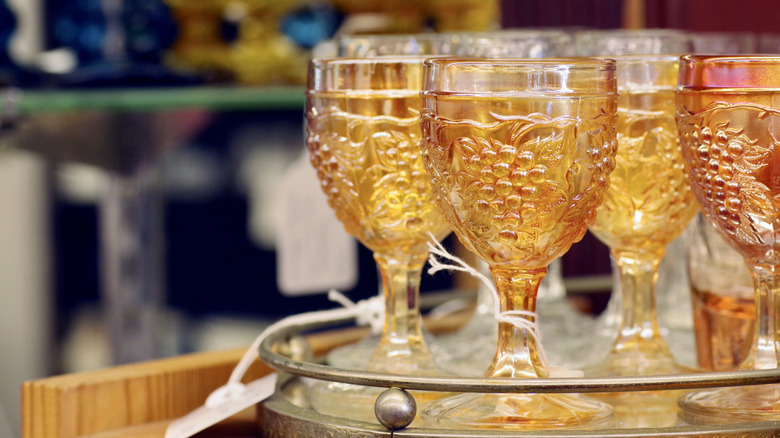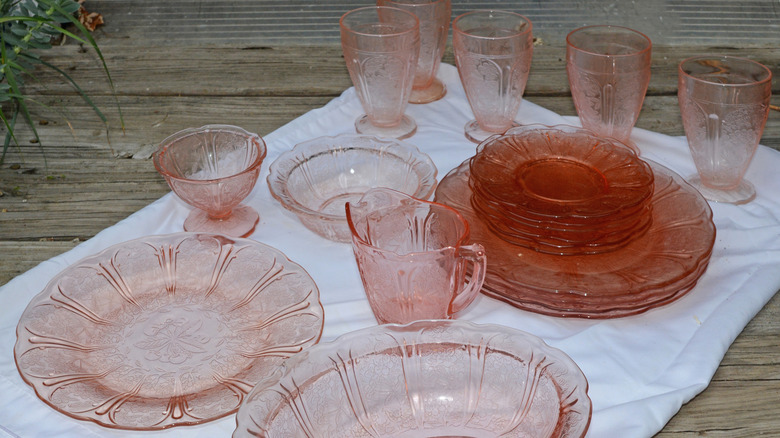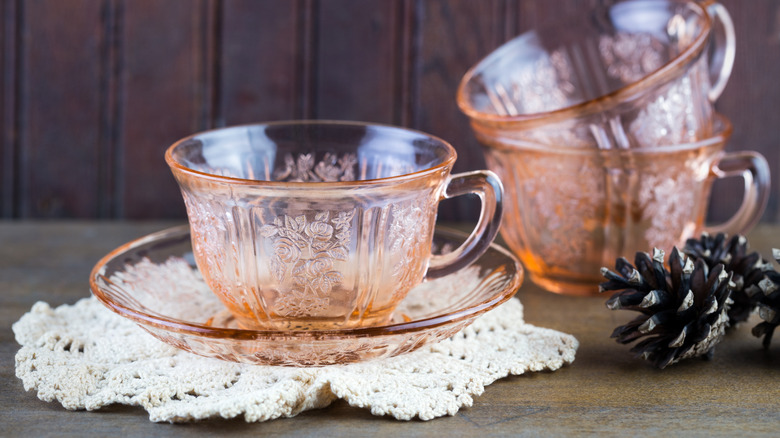The Depression Glass Look-Alike You Shouldn't Overlook At The Thrift Store
Glassware often floods thrift store shelves — you could find anything from trendy mugs sold by Target to vintage uranium glass and everything in between. Cluttered aisleways of multicolored pieces, some painted, others etched, beckon you to take them home and put them on display or add them to your mealtime rotation. Although tempting, it can be tricky to navigate the stockpile of glassware in the thrift store as you search for pieces that tell a story. But if you happen to stumble upon elegant glass, one depression glass look-alike, you might want to add it to your cart.
Depression glass can be a great find that is easy to spot and identify at the thrift store. Known for its vivid colors like cobalt, green, pink, red, and amber, depression glassware is playful and vibrant. However, elegant glass is an even higher-valued glassware that looks like depression glass and shouldn't be overlooked. Elegant glass, made around the same time as depression glass, looks similar but boasts hand-carved designs and etchings with fewer flaws. This glassware is more refined and of higher quality, making it a once-popular vintage item that everyone's snatching up at thrift stores again. If you're interested in adding some stunning vintage glassware to your home, there are a few things you need to know about elegant glass before you go on your next thrifting spree.
Elegant glass is the depression glass look-alike worth snagging
Elegant glass was produced during the same time period as depression glass, between the 1920s and 1950s. In order to distinguish these higher-quality pieces from the affordable glassware sold to the middle class, author Gene Florence coined the term, and collectors readily accepted the phrasing. Elegant glass was differentiated from depression glass due to the fact that the former was hand-crafted, hand-pressed, blown, fire-finished, and often etched, while depression glass was produced by machines and molds. Elegant glass had fewer mistakes or flaws and sold at a higher price tag. Now among some of the most treasured antique items dominating thrifting trends, elegant glass was once a common alternative to fine china.
Today, depression glass can be bought for $5 to $30 per piece, on average, depending on the item, color, and manufacturer. However, elegant glass is much more valuable. A Cambridge glass pitcher with rose etchings could be priced over $100, while a Heisey rose-etched glass pitcher could go for upwards of $240. Prices for elegant glass will differ depending on the shape, style, manufacturer, and color. Some iconic elegant glassware companies include Cambridge, Heisey, Morgantown, Fenton, Fostoria, Tiffin, and Westmoreland, but there were many "Hand Houses," places where hand finishes were added to glassware, that produced these pieces. Appraising them ultimately comes down to identifying the manufacturer and date of production, with some full collections worth thousands of dollars.
How to spot elegant glass in the thrift store
Though many depression glass and elegant glass pieces aren't especially valuable, some pieces which were made in only small batches at the time are sought by collectors. Before scouring the shelves, it's worth knowing how to spot authentic depression glass or elegant glass when shopping at estate sales, antique stores, or vintage markets. Depression glass is easy to spot due to its vivid colors and unique molds. Elegant glass, however, can be trickier since the glassware is often clear and adorned with hand-carved etchings. However, colorful elegant glass is also abundant in antique shops alongside depression glass counterparts. The key distinction between the two is simply the craftsmanship, one created by a mold and the other by hand. As such, depression glass may have detectable seams or imperfections from the mold while elegant glass does not.
Additionally, modern replicas of elegant glass might have painted designs, but elegant glass is notable for the incised surface. If you can scratch off the design with your thumbnail, it's not authentic elegant glass. Further, elegant glass can have an opalescent tint, unique patterns that help identify the manufacturer, a pontil mark from the rod used for hand-blowing glass, or mild wear that indicates it was once a cherished item in an early to midcentury household. Once you spot a piece and are fairly certain it's authentic, it could be a good idea to double-check with a professional to receive a proper appraisal.


